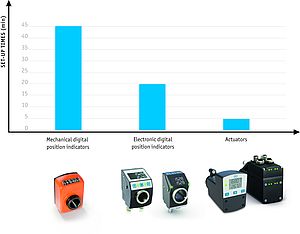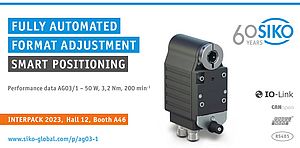The components deployed in the field of analytical technology are subject to stringent requirements, particularly sensors installed as part of the underlying measurement technology, which must include high-level precision, safety and imperviousness to external influences. The Black Forest-based SIKO GmbH company produces a wide range of equipment to measure length, angle and speed, which meets all the above requirements. The decision over whether to go for a magnetic or optical sensor and incremental or absolute measurement technology depends on the individual preferences and circumstances of customers, for whom SIKO has been developing tailor-made applications for over half a century.
There is no generic answer as to whether a magnetic or optical sensor is best suited for an application in analytical technology. Both show their strengths in the respective environments in which they are used. As a general rule though, optical sensors are particularly suitable for use in analytical technology given their ultra-precise recording of measured values to within a tolerance of +/- 5 µm plus exceptional resolution and repeatability (0.1 or 0.05 µm for the LSC20 optical sensor). Conversely, magnetic sensors (e.g. the MSK1000 as an incremental sensor and MSA111C as an absolute sensor) have fractionally lower system precision of up to +/- 10 µm, although benefits include their durability and cost efficiency: Operating on a contactless working principle eliminates wear as well as minimizing the maintenance required.
Optical sensors are more sensitive when it comes to soiling. As well as deciding on optical or magnetic sensors, the measurement method is another relevant issue. Here, the incremental method is the accepted standard, whereby a magnetic tape is regularly encoded with north and south poles. A sensor head, which houses sensor elements, moves at a predefined distance along the belt and reads the magnetic fields. The data is then internally counted - incremented - which is how incremental sensors work.
Absolute sensors, meanwhile, include a two-track belt, where one side includes an incremental track and the other track is absolutely encoded. This means that over any specified stretch of the belt, the encoding used is unique. The advantage here is that the sensor can always precisely determine its position. In the event of a power failure, however, when the incremental method is used, a reference run is required in order to bring the sensor back to a specified reference point, which is then relayed to the controller.
To eliminate this procedure, a battery can be installed as a back-up solution, which is activated if the main power supply fails. Indeed, this is a crucial safety precaution in many areas of medical and analytical technology. Using absolute sensor technology, however, completely eliminates this problem.
SIKO sensors in pipetting robots
The SIKO GmbH company is an experienced partner in the field of medical and analytical technology. One example of an end product created through such collaboration in analytical technology is a pipetting unit, which SIKO has equipped with magnetic measurement technology. One application for automatic or semi-automatic pipetting units is for blood analyses. They are equipped with linear motors used to position the individual axes.
There are three axes, on which pipetting robots move in all three dimensions. Here, magnetic absolute sensors are used to monitor the engine control and then transmit positional feedback to the control unit. Here, SIKO was extremely flexible in responding to customer requests, since two axes already had the customer's dedicated magnetic sensors installed, which meant SIKO only supplied the corresponding magnetic tapes including special encoding.
The longitudinal axis, in turn, includes a SIKO sensor with a matching magnetic tape. This assignment also involved working within an exceptionally confined area. The first-choice unit considered for installation was the MSA501 sensor, but spatial constraints ruled this out.
With that in mind, a PCB solution was chosen - namely limiting the installation to the PCB of the sensor and its sensor elements directly within the customer housing. A PCB solution alone is usually not feasible, particularly in areas prone to considerable soiling or where the sensor would be likely to come into contact with water. An enclosed space is generally needed, which constituted the existing housing of the pipetting robot in this case. One positive offshoot from the slimmed-down sensor solution including only the required components: cost savings for the customer.
Another area of analytical technology in which SIKO sensors are used is in centrifugal units. These centrifuges are popular as samples for use in DNA analyses, for example.



















